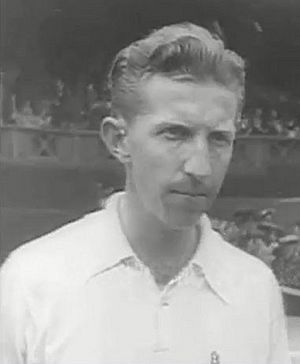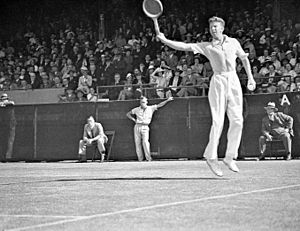Don Budge facts for kids
 |
|
| Full name | John Donald Budge |
|---|---|
| Country (sports) | |
| Born | June 13, 1915 Oakland, California |
| Died | January 26, 2000 (aged 84) Scranton, Pennsylvania |
| Height | 6 ft 1 in (185 cm) |
| Turned pro | 1938 (amateur tour from 1932) |
| Retired | 1955 |
| Plays | Right-handed (one-handed backhand) |
| Int. Tennis HoF | 1964 (member page) |
| Singles | |
| Career record | 569-278 (67.1%) |
| Career titles | 43 |
| Highest ranking | No. 1 (1937, A. Wallis Myers) |
| Grand Slam singles results | |
| Australian Open | W (1938) |
| French Open | W (1938) |
| Wimbledon | W (1937, 1938) |
| US Open | W (1937, 1938) |
| Professional majors | |
| US Pro | W (1940, 1942) |
| Wembley Pro | W (1939) |
| French Pro | W (1939) |
| Doubles | |
| Highest ranking | No. 1 (1942, Ray Bowers) |
| Grand Slam doubles results | |
| Australian Open | SF (1938) |
| Wimbledon | W (1937, 1938) |
| US Open | W (1936, 1938) |
| Grand Slam mixed doubles results | |
| Wimbledon | W (1937, 1938) |
| US Open | W (1937, 1938) |
Don Budge (born June 13, 1915 – died January 26, 2000) was an amazing American tennis player. He is famous for being the first person ever to win the "Grand Slam" in tennis. This means he won all four major tennis tournaments in the same year! He was also the only American man to do this.
Budge was the second male player to win all four Grand Slam events during his career. He is still the youngest player to achieve this. He won ten major titles in total. Six of these were Grand Slam events, and he won them in a row, which is a male record. He also won four "Pro Slams" on different types of courts. Many people thought Budge had the best backhand shot in tennis history. He is also the only male player to win the "Triple Crown" three times. This means he won the singles, doubles, and mixed doubles titles at the same tournament. He even did this twice in one year!
Contents
Early Life and Tennis Start
Don Budge was born in Oakland, California. His father was from Scotland and used to play soccer. Don played many sports when he was young before choosing tennis. He was tall and slim, which helped him develop one of the most powerful serves ever seen in tennis. Budge briefly studied at the University of California, Berkeley. But he left to join the U.S. Davis Cup tennis team.
Amateur Successes
Budge grew up playing on hard courts in California. So, he found it tricky to play on the grass courts in the eastern United States. But with a good coach and lots of practice, he got much better.
In both 1937 and 1938, he completely dominated Wimbledon. He won the singles title, the men's doubles with Gene Mako, and the mixed doubles with Alice Marble. He repeated this amazing "Triple Crown" feat at the U.S. Championships in 1938. Budge was the first man to win the Triple Crown at a Grand Slam event three times.
One of his most famous matches was in 1937 against Gottfried von Cramm from Germany. This was during the Davis Cup finals. Budge was losing badly in the last set, 1-4, but he fought back to win 8-6! His victory helped the U.S. team win the Davis Cup for the first time in 12 years. Because of his great efforts, he was named the Associated Press Male Athlete of the Year. He also became the first tennis player to win the James E. Sullivan Award. This award goes to America's top amateur athlete.
In 1938, Budge was unstoppable in amateur tennis. He won the Australian Open by beating John Bromwich. Then he won the French Open against Roderick Menzel. Next, he won Wimbledon without losing a single set, defeating Bunny Austin. Finally, he won the U.S. Championships against Gene Mako. This made him the first person ever to win the Grand Slam in tennis! He is also the youngest man to complete the "Career Grand Slam." This means he won all four major tournaments at some point in his career. He achieved this on June 11, 1938, just two days before his 23rd birthday.
Becoming a Professional Player
After winning the Grand Slam in October 1938, Don Budge became a professional tennis player. This meant he would play for money instead of just for trophies. In 1939, he beat two of the best professional tennis players: Ellsworth Vines (22 matches to 17) and Fred Perry (28 matches to 8). That year, he also won two big pro tournaments: the French Pro Championship and the Wembley Pro tournament.
In 1940, Budge continued to be the world's best. He won four major events, including the United States Pro Championship, where he beat Fred Perry in the final. In 1942, Budge won his last major tour, beating players like Bobby Riggs and Frank Kovacs. He also won the U.S. Pro at Forest Hills for a second time, easily defeating Bobby Riggs.
Serving in World War II
In 1942, Budge joined the United States Air Force to serve in World War II. Early in 1943, he hurt his shoulder badly during an obstacle course. This injury affected his tennis playing for the rest of his career. Even with the injury, he continued his military duties.
During the war, Budge played some exhibition matches for the troops. In 1945, he played against Bobby Riggs, who was also a top player. They played five matches on different islands. Budge won the first two, but Riggs won the next three. This gave Riggs a mental advantage for their future matches after the war.
After the War
After World War II, Budge continued to play professional tennis for several years. He often played against Bobby Riggs. In 1946, Budge lost a close tour to Riggs, 24 matches to 22. This made Riggs the new world No. 1 in professional tennis.
Budge still won some tournaments in 1946, beating Riggs in several finals. But Riggs beat Budge easily in the final of the U.S. Pro that year. Riggs often used lob shots to make Budge run more, which tired him out. Budge reached two more U.S. Pro finals, but he lost to Riggs in 1949 and to Pancho Gonzales in 1953.
In 1954, Budge had his last big victory on a North American tour. He defeated Pancho Gonzales, who was then the best player in the world. In 1955, Budge won the U.S. Pro Clay Court Championships, beating Riggs in the final.
Later Years and Awards
After he stopped playing professionally, Don Budge became a coach. He held tennis clinics to teach children how to play. He was known as a true gentleman on and off the court. He was often asked to give speeches and supported different sports brands.
When tennis became "Open" in 1968 (meaning pros and amateurs could play together), Budge returned to Wimbledon. He played in the Veteran's doubles. In 1973, at 58 years old, he and former champion Frank Sedgman won the Veteran's Doubles Championship at Wimbledon. The crowd loved it!
Don Budge was added to the International Tennis Hall of Fame in 1964. This is a special place that honors the greatest tennis players. The tennis courts at Bushrod Park in Oakland, where he played as a kid, are named after him.
In December 1999, Budge was in a car accident. He never fully recovered and passed away on January 26, 2000, at the age of 84.
Why Don Budge Was Great
Many tennis experts believe Don Budge was one of the greatest players of all time. He had a smooth, powerful backhand shot that was hard to return. Combined with his speed and strong serve, this made him the best player of his era.
Some experts, like E. Digby Baltzell, said Budge and Rod Laver were usually ranked at the top of all-time lists. Will Grimsley wrote that many considered Budge the best ever. Jack Kramer, another tennis legend, said Budge was "the best of all" because he had "the most perfect set of mechanics." Kramer also said that even when Budge was 38, other top players struggled to return his serve.
In polls and fantasy tournaments, Budge is almost always ranked among the top five or six greatest tennis players ever. Only a few other players, like Bill Tilden and Rod Laver, have received such high praise for so long.
Major Tournament Wins
Grand Slam Singles Titles: 6
- 1937 Wimbledon
- 1937 U.S. Championships
- 1938 Australian Championships
- 1938 French Championships
- 1938 Wimbledon (2)
- 1938 U.S. Championships (2)
Grand Slam Doubles Titles: 4
- 1936 U.S. Championships (with Gene Mako)
- 1937 Wimbledon (with Gene Mako)
- 1938 Wimbledon (with Gene Mako)
- 1938 U.S. Championships (with Gene Mako)
Grand Slam Mixed Doubles Titles: 4
- 1937 Wimbledon (with Alice Marble)
- 1937 U.S. Championships (with Alice Marble)
- 1938 Wimbledon (with Alice Marble)
- 1938 U.S. Championships (with Alice Marble)
Pro Slam Singles Titles: 4
- 1939 Wembley Pro
- 1939 French Pro Championship
- 1940 US Pro Championships
- 1942 US Pro Championships
Amazing Records
Don Budge set many records before the "Open Era" of tennis began in 1968.
| Championship | Years | Record accomplished | Player tied | Ref |
|---|---|---|---|---|
| Grand Slam tournaments | 1938 | Won the Calendar Year Grand Slam (all 4 Major singles titles in one year) | Rod Laver | |
| Grand Slam tournaments | 1937–38 | Won 6 consecutive Grand Slam singles titles | Stands alone | |
| Grand Slam tournaments | 1938 | Youngest male player to achieve the Grand Slam (23 years, 3 months) | Stands alone | |
| Grand Slam tournaments | 1937–38 | Youngest male player to achieve the Career Grand Slam (22 years, 11 months) | Stands alone | |
| Grand Slam tournaments | 1937–38 | Achieved the "Triple Crown" (singles, doubles, mixed doubles) 3 times at Grand Slam events (Wimbledon 1937–38, US Championships 1938) | Stands alone | |
| Grand Slam tournaments | 1937–38 | 37 match win streak in consecutive tournaments | Stands alone | |
| Grand Slam tournaments | 1934–38 | 92.06% (58–5) Career winning percentage | Stands alone | |
| Grand Slam tournaments | 1938 | 100% (24–0) Single Season winning percentage | Rod Laver Jimmy Connors |
|
| Grand Slam tournaments | 1934–38 | 91.22% (52–5) Career Grass Court winning percentage | Stands alone | |
| All tournaments | 1937–38 | 14 consecutive tournament wins | Stands alone |
Images for kids
See also
 In Spanish: Don Budge para niños
In Spanish: Don Budge para niños




